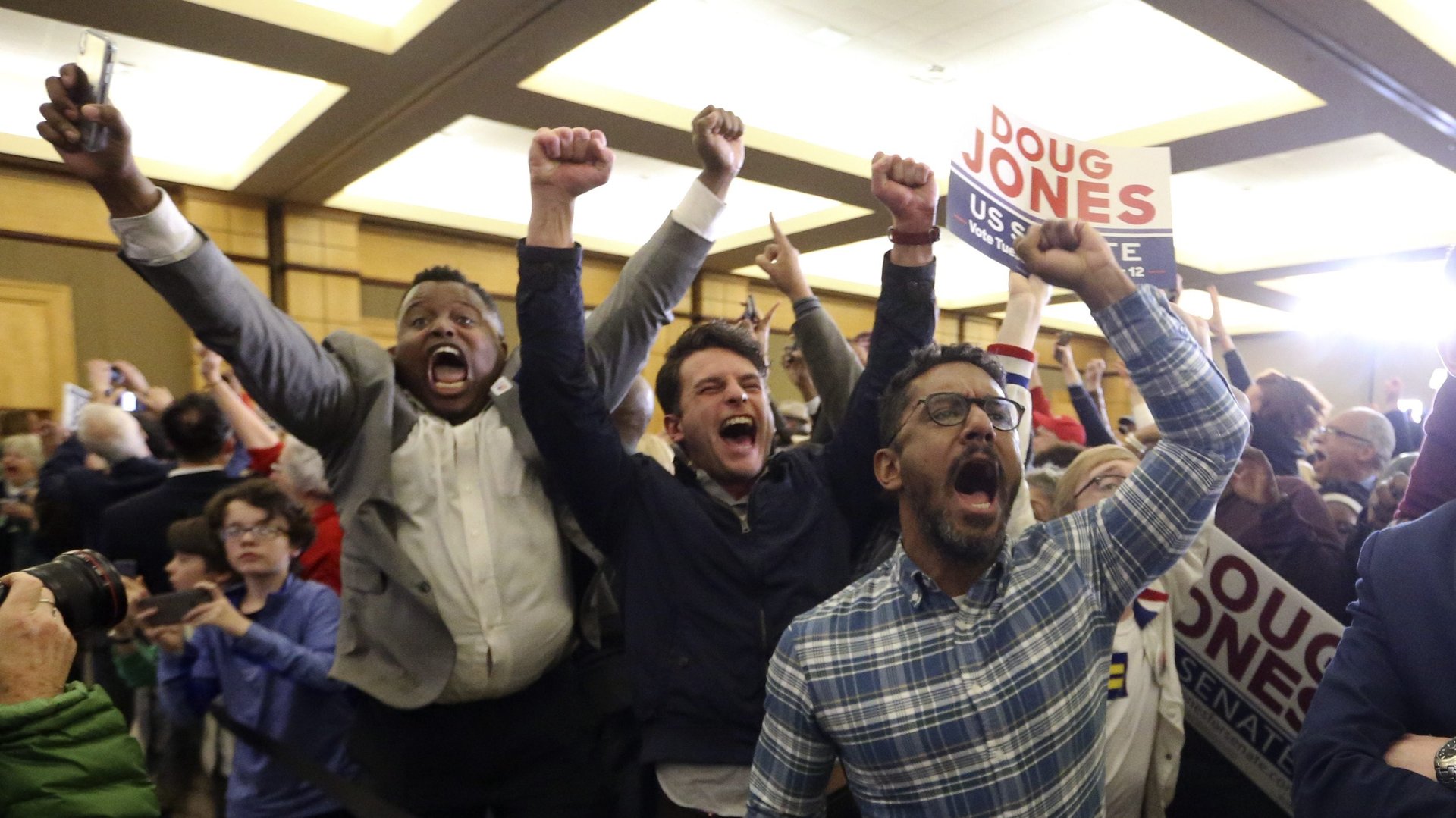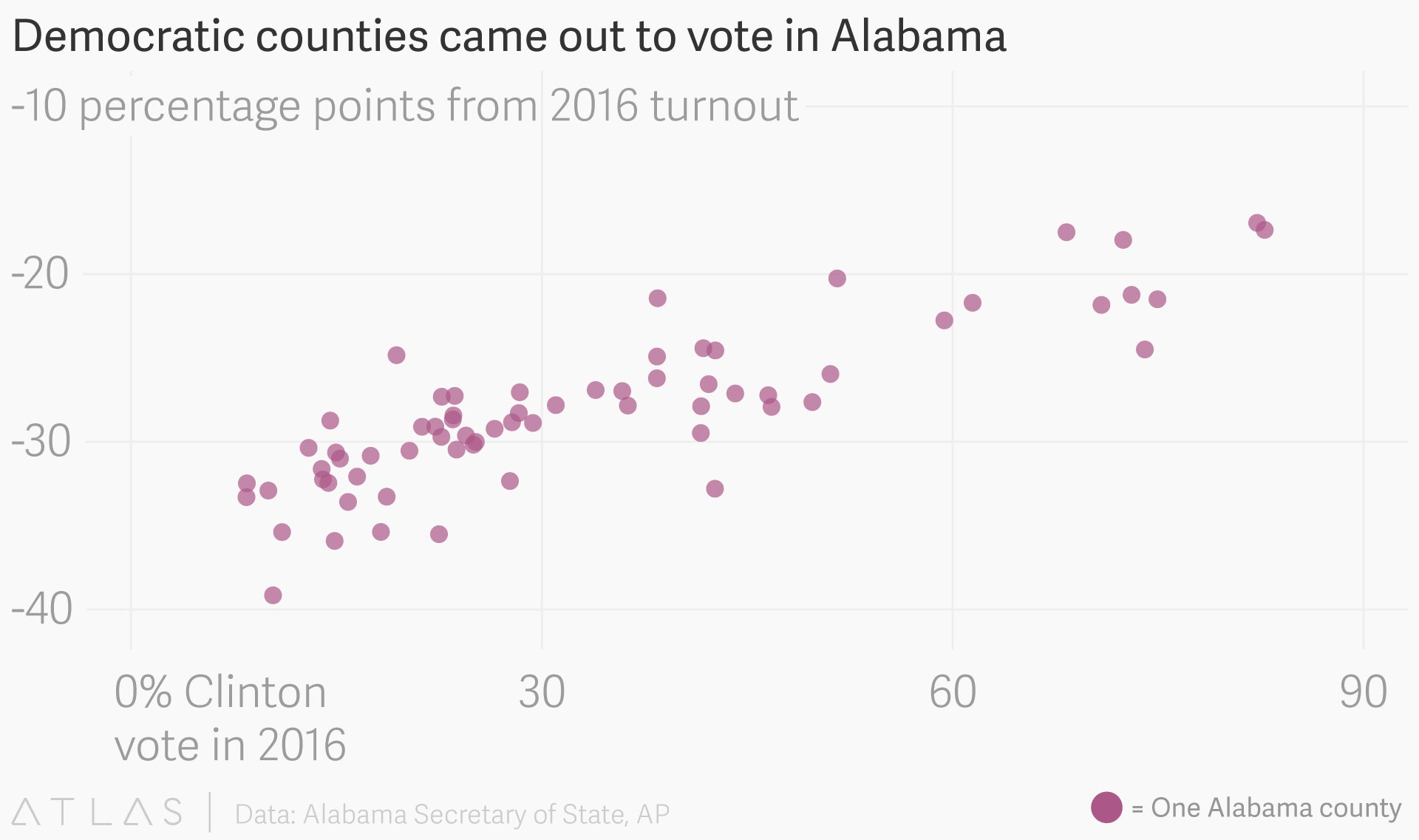“Black voters turned out” isn’t the full story of Alabama’s surprise Democratic win
In 2014, Democrats thought winning a senate seat in Alabama was such a long shot that they didn’t even field a candidate—Republican Jeff Sessions, now US attorney general, ran unopposed and won.


In 2014, Democrats thought winning a senate seat in Alabama was such a long shot that they didn’t even field a candidate—Republican Jeff Sessions, now US attorney general, ran unopposed and won.
But the special senate election to replace Sessions on Tuesday (Dec. 12) shows that Alabama—and potentially other deeply red jurisdictions—are not a lost cause for Democrats. Doug Jones, a former federal prosecutor who has never held elected office, beat his Republican opponent Roy Moore, even if by a small margin.
His unexpected victory is a sign of hope for Democrats heading toward the 2018 mid-term elections—and a cause of worry for Republicans. Here are a few reasons why:
Democrats are fired up in opposition
Donald Trump won 62% of the vote in Alabama in the 2016 presidential election. Less than a year later, the senate candidate that he endorsed couldn’t muster 50%. That result is no doubt related to Republican apathy, but a bigger factor was enthusiasm by Democrats.
In the hours since the election, much attention has been paid to the role black voters played in opposing Moore. African Americans make up nearly 60% of Alabamans who identify as Democrats, according to a Pew survey. But after turning out in big numbers for then president Barack Obama in 2012, their participation had waned in more recent races.
Preliminary data from Tuesday’s election suggest African Americans returned to the polls at roughly the same rates they did in 2012. That’s a remarkable accomplishment, considering that voters don’t usually get very excited about mid-term races.
They were not alone, though—across the board, Democrats of all races appear to have turned out to swing Alabama blue. To quantify this, we compared the overall turnout in this special election to overall support for Hillary Clinton in 2016. The correlation is very strong: counties that supported Clinton came out to vote.

The turnout number is negative because the number of votes in special or midterm elections is almost always lower than in national elections. So the chart shows that in counties that had more votes for Clinton in 2016, turnout did not fall as much as in counties with fewer votes for her, even though it was an odd year.
A simple regression analysis shows that an extra 10 percentage points of Clinton vote share is correlated with about 2 more percentage points of voter turnout in the special election. The correlation is not as strong if we just look at how much of a county’s population is black, though as the largest group of Democratic voters in the state, African Americans were the most important in bringing about this result.
Campaigning paid off even in a red state
Moore’s antics played a role in getting Alabamans to show up at the polls, but they were also prodded by one of the most ambitious efforts by Democrats to turn out the vote in Alabama in a generation, according to Kevin Akins, a Democratic pollster in Alabama.
The Democratic candidate raised more than five times the amount of money from state donors than his Republican opponent. National leaders also contributed to the effort, behind the scenes at first, and then openly in the days before the election. Former president Barack Obama and his vice-president Joe Biden strongly urged voters to get to the polls. Organizers paid special attention to the African American community, reaching out to them directly with mailers, digital adds, and face-to-face interactions.
It was an unusual rollout in a state where the opportunities for Democrats have been slim for years. The extra investment and energy put into the special election paid off in Alabama—and it could too in other places if Democrats can tap into voters’ frustrations with the Trump administration. Preliminary exit polls show that the sex allegations against Moore were not the only deciding factor for most of the people who didn’t vote for him.
Meanwhile, disapproval of the Trump administration was a near perfect indicator for votes for Jones: 93% of those who supported him don’t think the president is doing a good job, according to data from the Washington Post.
Of course, Alabama’s contest was exceptional in several ways, starting with Moore, an accused pedophile with controversial views on race and religion. He was an unusually divisive candidate, even by the standards set by Donald Trump in the presidential election. It’s hard to imagine other contenders with the same potential to put off both Democrats and Republicans. Black voters, credited with pushing Jones to victory, don’t make as big a share of the electorate in other places.
Nevertheless, voter data behind the upset in Alabama suggest that now is the time for politicians to tap into Democrats’ energy and frustration, across all demographics and even in unlikely states. For Akins, the message Alabama Democrats sent with their vote is clear: “I’m fed up with this administration and with the Republicans and I’m excited enough to get off the couch.”